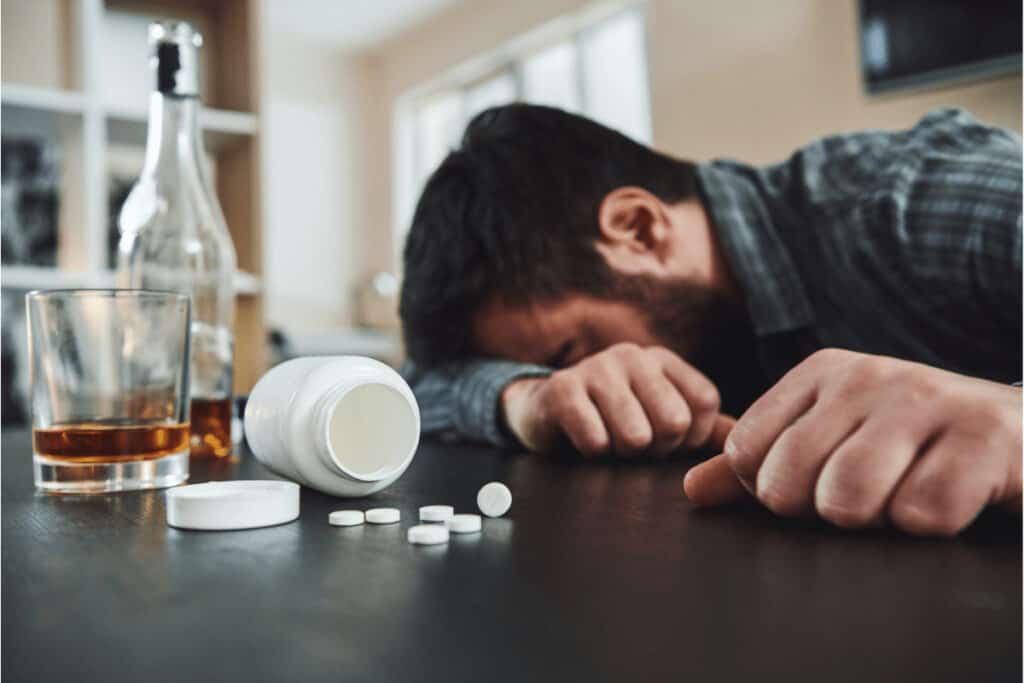Combining substances of abuse, whether intentional or unintentional, is a very dangerous practice and can even be deadly. Sometimes, individuals may drink alcohol with a prescription drug when there is a warning on the prescription bottle not to do so. They may not have read the warning on the bottle, so this would have been unintentional. Then again, there are some individuals who use illicit drugs that will combine them to enhance the “high” that they experience.
What Is Polydrug Use?
Intentionally Combining Substances of Abuse
Two illegal street drugs that users often combine are heroin and cocaine. The slang name for this is “speedballing.” The user mixes the heroin and cocaine and either snorts it nasally or injects it into the bloodstream. Users who speedball say they have a longer-lasting and more intense high than when they use the two drugs separately. Speedballing is very dangerous and can lead to an overdose, maybe even a fatal overdose.
Combining a stimulant with a depressant stresses the entire system of the user, the brain, lungs, and heart especially. While one drug is trying to speed up the system, the other is trying to slow it down.
Some of the fatal side effects associated with speedballing include:
- Respiratory failure
- Heart attack
- Stroke
- Aneurysm
The effects of cocaine wear off more quickly than the effects of heroin. Therefore, the slowed respiration due to the heroin will become more intense when the cocaine effects are gone.
Legal Ramifications of Polydrug Use
The legal consequences of polydrug use can be severe and vary widely depending on the substances involved and the jurisdiction. Engaging in polysubstance use, especially involving controlled substances, can lead to enhanced penalties under drug laws. This includes longer prison sentences, larger fines, and more severe charges like distribution or trafficking, particularly when substances like opioids or stimulants are combined with alcohol. These legal issues affect the individual and increase the strain on the judicial and prison systems.
The Role of Peer Pressure in Substance Abuse
Peer pressure plays a significant role in substance abuse, particularly among younger demographics. The desire to fit in or be part of a group can lead individuals to engage in substance use, including polysubstance use. This is often seen in settings where alcohol use is normalized, and the addition of prescription drugs or illegal substances like cocaine can escalate, increasing the risk of overdose deaths. Education and supportive community programs are crucial in helping individuals resist peer pressure and make informed choices about substance use.
The Psychological Impact of Polydrug Abuse
Polydrug abuse significantly impacts mental health, leading to complex psychological disorders. Users may experience enhanced symptoms of anxiety, depression, or psychosis as a result of the conflicting effects of multiple substances, such as a stimulant and a sedative. This can complicate treatment for substance use disorder, as the psychological effects can be unpredictable and severe. Long-term abuse can lead to lasting cognitive impairments, making recovery a challenging yet critical endeavor.
Long-term Health Consequences of Chronic Substance Abuse
Chronic substance abuse, particularly involving multiple substances, has devastating long-term health consequences. Continuous exposure to various chemicals can lead to liver damage, cardiovascular diseases, respiratory issues, and neurological damage. The combination of substances like alcohol and opioids can dramatically increase the risk of life-threatening conditions, including irreversible organ damage and overdose. These health issues require comprehensive treatment strategies that address both the physical and psychological aspects of recovery.
Combining Alcohol with Other Substances
Combining substances of abuse such as alcohol and prescription opioids is fairly common today. Many individuals who misuse prescription drugs also engage in binge drinking. Misusing these two substances together can easily lead to a fatal overdose. Prescription opioids are dangerous when taken alone. However, combining them with alcohol increases the dangers of depressed breathing, leading to death.
Combining benzodiazepines with alcohol can also lead to overdose and death. Benzodiazepines are anti-anxiety medications such as Xanax and Valium. These drugs act on GABA (gamma-aminobutyric acid) receptors. In the same way, alcohol acts on these same receptors in the brain. People may use alcohol to enhance the effects of the benzodiazepine or use Benzo to enhance the effects of alcohol. These combinations also can lead to overdose and death.
Another bad combination of substances is stimulants and alcohol. Many college students abuse central nervous system stimulants such as Adderall. Students who have prescriptions for medication for ADHD often sell these drugs to other students. They use them as “study drugs” when they have to cram for a test or stay up all night doing research for projects. In addition, they will take stimulants along with alcohol when they are partying.
The stimulant will mask the effects of the alcohol, and the individual does not realize that they are drinking far too much. In cases such as these, alcohol poisoning can easily occur. Many times, the individual will also take more of the stimulant drug, leading to an overdose. There is an increased risk of high blood pressure, stroke, or heart attack. There is also the potential for liver and kidney damage from combining these two substances.
The Dangers of Street Drugs
When individuals buy drugs from dealers on the street, they have no idea what is actually in the substance they are purchasing. There have been many cases of drug overdoses when heroin is combined with fentanyl. The person may think they are buying straight heroin when the heroin is laced with other drugs.
In addition, there is no way of knowing how pure the heroin may be. Dealers will cut this drug with other products to increase their profits from the substance. They may add talcum powder, baking soda, or some substance that can harm the user.
Contact Virtue Recovery Center
If you are struggling with addiction or combining substances of abuse, seek help from a reputable addiction treatment facility. Do not continue taking chances with your life. Combining substances of abuse is dangerous and often deadly.
Contact one of our representatives at Virtue Recovery Center to learn about our different treatment programs. We can design a program that will fit your individual needs and preferences. Don’t wait any longer—contact us today!
FAQ
What is it called when drugs are combined?
When drugs are combined, it is often referred to as polydrug use, drug combinations, or polysubstance use.
What drugs should never be taken together?
Certain drugs should never be mixed due to increased risks of lethal outcomes, such as sedatives combined with alcohol, which can greatly increase the risk of overdose deaths.
Why is it dangerous to combine drugs and alcohol because of medication?
Combining drugs and alcohol is dangerous because it can lead to severe adverse effects, compound impairment, and heighten the chance of fatal respiratory depression.
What is an example of substance misuse?
An example of substance misuse is taking prescription medications in a way not intended by the prescribing doctor.
What are four substances that are often misused?
Commonly misused substances include alcohol, opioids, benzodiazepines, and stimulants.
Could drug use lead to hair loss?
Yes, certain drug use, particularly when it involves substance abuse of drugs like cocaine, can lead to hair loss due to the body’s negative reaction to toxins.
How common is polydrug use?
Polydrug use is quite common among those with a substance use disorder, as many individuals use multiple substances to enhance the effects of each or counteract adverse effects.
Resources
- cdc.gov – More than Half of People who Misuse Prescription Opioids also Binge Drink
- https://adf.org.au/reducing-risk/polydrug-use/
- https://www.ncbi.nlm.nih.gov/pmc/articles/PMC9602920/



























